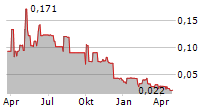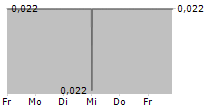
TORONTO, ON / ACCESSWIRE / April 25, 2024 / Velox Energy Materials Inc. (TSXV:VLX) ("Velox" or "the Company") is pleased to provide an update on results received from its Phase 1 metallurgical testwork program completed on samples from the Cambridge Vanadium Deposit at the North Queensland Vanadium Project ("NQVP" or "the Project").
Highlights
- Sizing of three (3) composite samples completed.
- Findings indicate a significant improvement in V 2 O 5 grade from within the -38µm fraction.
- Head grade results of 0.23% V 2 O 5 from Composite 1 and 0.41% V 2 O 5 from Composite 2 received.
- Pre-scrub results from the first two composites returned significant improvements to head grade including:
- Composite 1 (-9.5mm sub split) within the -38µm fraction returning assays of 0.84% V 2 O 5 ;
- Composite 2 (-9.5mm sub split) within the -38µm fraction returning assays of 0.98% V 2 O 5 .
Three composite samples were created from four diamond drillholes completed in September 2023 [1] and submitted to Brisbane Met Labs (BML), an expert in the assessment of North Queensland vanadium deposits, to assess mineral recovery within identified stratigraphic horizons of the prospective Toolebuc Formation. Assay results of up to 0.98% V 2 O 5 were achieved within the -38µm fraction indicating a significant 2.4 to 3.65 times improvement in grade.
Velox's President and CEO, Simon Coyle, commented:
"Our understanding of the stratigraphy and the various horizons within the mineralised zone has improved considerably as a result of last year's diamond drilling program and this work has led the direction of the current metallurgical testwork. These initial results have confirmed that there is scope to improve head grade through simple first pass sizing of selected horizons.
"To have a pre-float grade of 0.98% V 2 O 5 is extremely pleasing and provides an excellent platform to further increase the V 2 O 5 grade and consequently see an outcome in concentrate grades that may be substantially higher.
"Mineralisation is near surface (which implies a low strip ratio), occurs in soft flat lying oxidised sediments (implying low cost mining) and coupled with the sizing results and the identification of vanadium in the -38µm fraction, we have increased confidence in the successful economic and technical extraction of vanadium."
Cambridge Mineral Resource - Toolebuc Formation
As per Figure 1, the separation of the Toolebuc can be seen, which has been derived by separating the Toolebuc into a series of stratigraphic horizons based on lithological, mineralogy, and geochemical variations observed. The horizons represent distinctive stages in the deposition of the Toolebuc Formation and mineralisation. The horizon variation has material significance to understanding the deposit and mineral processing.

Figure 1: NQVP Cambridge Vanadium Deposit Cross Section
TLBA :
| |
TLBB :
| |
TLBC :
| |
TLBD :
| |
TLBE :
|
Metallurgical Testwork Program
Four diamond drill holes were selected to represent the Cambridge Vanadium Deposit (NQP23_002, NQVP23_003, NQVP23_006 and NQVP23_008), with three geological horizons (A,B/C and D) within the Toolebuc Formation being identified from drill logging and assays for testwork:
- Composite 1: Represents horizon A
- Composite 2: Represents horizon B/C
- Composite 3: Represents horizon D
Assays and quantitative XRD analyses of the head size were completed by BML as part of the testwork program.
Metallurgical Testwork Results
The results of the testwork have been assessed by Velox metallurgical consultants, BHM Process Consultants (BHM), with the following key observations identified :
- A strong correlation between the head assays and the drill assays was identified.
- Head grade results for of 0.23% V 2 O 5 from Composite 1 and 0.41% V 2 O 5 from Composite 2 received.
- Pre-scrub results proved very promising with results including:
- Composite 1 (-9.5mm sub split) within the -38µm fraction returning assays of 0.84% V 2 O 5 ;
- Composite 2 (-9.5mm sub split) within the -38µm fraction returning assays of 0.98% V 2 O 5 .
These findings indicate a significant improvement of 2.4 - 3.65 times in V 2 O 5 grade from the original sample to the mass within the -38µm fraction.
Next Steps
The positive findings from the Phase 1 metallurgical testwork program provide a solid foundation for the next phase of testwork (Phase 2), which will include:
- Receipt of Composite 3 results;
- Bulk scrubbing of Composites 1 and 2; and
- Commencement of sighter flotation testing.
Velox anticipates results from Phase 2 testwork will be concluded by the end of Q2 CY24. Continued updates will be provided as and when results are received.
Sample Analysis and QA/QC Program
Velox uses a quality assurance/quality control (QA/QC) program that monitors the chain of custody of samples and includes the insertion of blanks, duplicates, and reference standards in each batch of samples sent for analysis. The drill core is photographed, logged, and longitudinally cut, then ¼ core sampled and shipped for analysis. The ¾ retained sample is held in a secured location for verification purposes. Sample preparation (drying, crushing and pulverizing) is performed at Mitra PTS Laboratory, an independent (NATA Accreditation No 14525) laboratory, in Gladstone, Queensland, Australia. The entire sample is crushed to 70% passing -6 mm, and a riffle split of 250 grams is taken and pulverized to 75 microns. Pulps are sent to Bureau Veritas, in Perth, Australia (and other independent Laboratories) for analysis with the sample and pulp rejects stored as reserve.
Mitra PTS also complete density, moisture, carbon and sulfur testing on all samples.
Samples are analysed for vanadium and 50 other trace elements using Laser Ablation ICP-MS (LA101) from a 30-gram pulp. All samples are also subject the assay by XRF (XF202), testing 13 major element oxides with Umpire laboratory checks completed by ALS in Brisbane using lithium-borate fused digest ICP-MS (ME-MS81) at 1:10 sample ratio.
Blind duplicates were included in the (LA101/XF202) at a 1:10 sample ratio and certified reference standards (CRSs) and blanks were included in the assay program, including CRSs selected to represent the expected vanadium assay grades.
No QA/QC issues were noted with the results reported herein.
About Velox Energy Materials
Velox Energy Materials is a publicly traded energy materials company developing and progressing high-value assets in resource and research-friendly jurisdictions. The Company's priority focus is the advanced NQV Project in Queensland, Australia. The NQV Project hosts the Cambridge Deposit with an CIM compliant Indicated Mineral Resource of 61.33 Mt @ 0.34% V 2 O 5 and 234.6 ppm MoO 3 along with an Inferred Mineral Resource of 144.87 Mt @ 0.33% V 2 O 5 ( cut-off grade of 0.25% V2O5) and 241.9 ppm MoO 3 (Dufresne et al., 2022). The Company is targeting shallow, high-grade mineralisation that can be developed using low-cost mining and processing options.
The Company additionally owns Kotai Energy and the option to acquire 100% of the intellectual property rights associated with the Solid-State Hydrogen Storage Project from Curtin University in Western Australia. Kotai is focused on the commercialisation of technology that can produce high-pressure hydrogen following transport as an inert powder.
In October 2023, the Company acquired a package of tenements that are prospective for lithium in eastern Quebec.
Please visit our website at www.veloxenergymaterials.com.au for further information.
Approved by the Board of Velox Energy Materials Inc.
Investor Relations Contact
Andrew Rowell |
Qualified Persons
The Velox Energy Materials technical information in this news release has been prepared in accordance with the Canadian regulatory requirements set out in National Instrument 43-101 (Standards of Disclosure for Mineral Projects) and reviewed and approved on behalf Velox Energy Materials by Michael Griffiths, FAusIMM, Director & VP Exploration for Velox Energy Materials, a Qualified Person.
Forward Looking Statements
Neither the TSX Venture Exchange nor its regulation services provider (as that term is defined in the policies of the TSX Venture Exchange) accepts responsibility for the adequacy or accuracy of this release.
This news release may contain forward-looking statements that are based on the Company's expectations, estimates and projections regarding its business and the economic environment in which it operates. Statements about the closing of the transaction, expected terms of the transaction, the number of securities of Velox Energy Materials that may be issued in connection with the transaction, and the parties' ability to satisfy closing conditions and receive necessary approvals are all forward-looking information. These statements are not guarantees of future performance and involve risks and uncertainties that are difficult to control or predict. Therefore, actual outcomes and results may differ materially from those expressed in these forward-looking statements and readers should not place undue reliance on such statements. Statements speak only as of the date on which they are made, and the Company undertakes no obligation to update them publicly to reflect new information or the occurrence of future events or circumstances, unless otherwise required to do so by law.
The figures noted in this announcement are in USD and sourced from the Future of Hydrogen Report prepared by the IEA. They are not actual costs nor forward looking statements or financial forecasts and are not indicative of the future performance of the Company
[1] VLX Announcement dated 24 January 2024: Velox drilling identifies high-grade vanadium zone within the Cambridge Deposit in Queensland, Australia
SOURCE: Velox Energy Materials Inc.
View the original press release on accesswire.com


